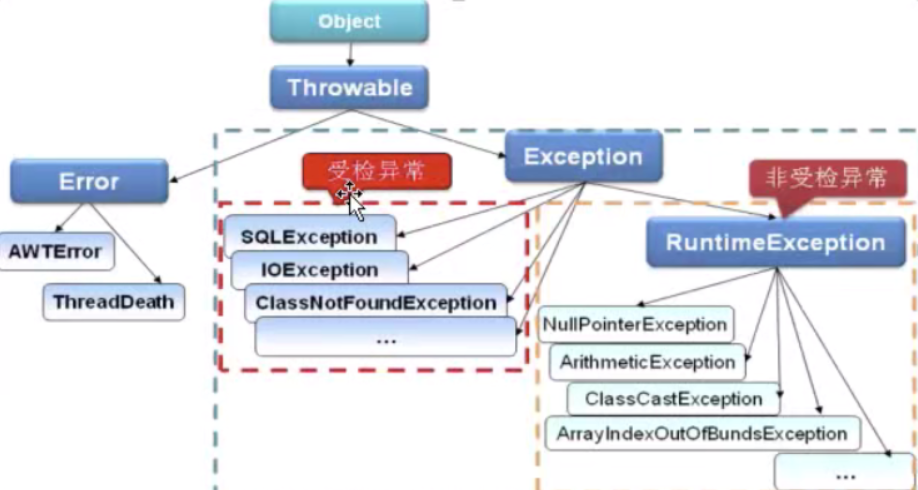Java 异常
Throwable是Error和Exception的父类,在开发中只关注Exception
Exception可分为编译期异常(受检异常)和运行期异常(非受检异常)
异常会导致程序中断,无法继续执行。处理异常可以让程序保持运行状态
在开发中常把 try 将可能出现异常的代码块包裹起来。使用 catch 捕捉异常,catch可以有多个,异常子类放前面,异常父类放后面。
异常处理过程分析:
(1)一旦产生异常,则系统会自动生成一个异常类的实例化对象
(2)如果异常发生在try语句块内,系统会自动寻找匹配的catch代码块执行。若异常产生之后没有异常处理语句,则程序就会退出,并报告异常错误

代码示例:
public class TestException { public static void main(String[] args) { /* * 值得注意的是:在try代码块中,若某行代码发生异常,那么程序立即跳转至处理异常的代码块(比如catch代码块) * 发生异常所在行后面的代码将无法正常执行 * finally代码块无论是否发生异常,都会执行 */ try { int a=6; int b=2; int c= a/b; int [] arr = {1,2,3,4}; System.out.println(arr.length); System.out.println(arr[3]); arr = null; System.out.println(arr[3]); } catch(ArithmeticException e) { System.out.println("发生算数异常"); } catch(ArrayIndexOutOfBoundsException e) { System.out.println("发生数组越界异常"); } catch(NullPointerException e) { System.out.println("发生空指针异常"); } catch(Exception e) {
e.printStackTrace(); System.out.println("程序发生异常"); } finally { System.out.println("程序运行完毕"); } } }
throw与throws关键字(抛出异常,并不是处理异常):
(1)throws关键字用在方法的声明上,表示方法中并不处理异常,而交给调用方法处进行处理。对于Java程序而言,如果没有加入任何的异常处理,发生的异常则由JVM处理(不处理,显示报错)
(2)throw表示在方法中手动抛出一个异常。从异常处理的机制来看,所有的异常一经产生,系统实际上抛出的是一个异常类的实例化对象,那么此对象也可以由throw直接抛出
public class TestThrows { public static void main(String[] args) { try{ divide(6,0); } catch(ArithmeticException e) { System.out.println("发生了算术异常"); } } //throws和throw 常搭配使用 public static int divide(int a,int b) throws ArithmeticException{ try{ int c = a/b; return c; } catch(ArithmeticException e) { throw new ArithmeticException("发生了算术异常"); } } }
自定义异常
自定义异常通常是继承一个异常类(Throwable、Exception、RuntimeException)来实现。
自定义异常,使用提供构造方法来实现。
异常对象本身没有实际功能,仅是一个具有特殊意义的标识
public class TestMyexception2 { public static void main(String[] args) { UserService1 us1 = new UserService1(); try { us1.login("", ""); } catch (MyException e) { e.printStackTrace(); } } } //自定义异常,继承异常类 class MyException extends Exception{ public MyException() { super(); } public MyException(String message) { super(message); } } class UserService1{ public User login(String username,String password) throws MyException{ if(!"admin".equals(username)) { throw new MyException("用户名错误"); } if(!"123".equals(password)) { throw new MyException("密码错误"); } return new User(username,password,18); } } class User{ private String username; private String password; private int age; public User() { super(); } public User(String username, String password, int age) { super(); this.username = username; this.password = password; this.age = age; } public String getUsername() { return username; } public void setUsername(String username) { this.username = username; } public String getPassword() { return password; } public void setPassword(String password) { this.password = password; } public int getAge() { return age; } public void setAge(int age) { this.age = age; } }
受检异常:Exception
在定义方法时,必须声明出所有可能抛出的Exception;
调用该方法时,必须捕获它的checked exception,不然就得把exception传递下去
exception是从 java.lang.Exception中衍生出来的。例如:IOException 、SQLException等等
非受检异常:RuntimeException
在定义方法时不需要声明会抛出runtime exception;
在调用这个方法时不需要捕获这个runtime exception;
runtime exception是从 java.lang.RuntimeException 或 java.lang.Error中衍生出来的。例如:NullPointerException 、ArrayIndexOutOfBoundsException等等
本文来自博客园,作者:藤原豆腐渣渣,转载请注明原文链接:https://www.cnblogs.com/javafufeng/p/16298167.html





【推荐】国内首个AI IDE,深度理解中文开发场景,立即下载体验Trae
【推荐】编程新体验,更懂你的AI,立即体验豆包MarsCode编程助手
【推荐】抖音旗下AI助手豆包,你的智能百科全书,全免费不限次数
【推荐】轻量又高性能的 SSH 工具 IShell:AI 加持,快人一步
· TypeScript + Deepseek 打造卜卦网站:技术与玄学的结合
· 阿里巴巴 QwQ-32B真的超越了 DeepSeek R-1吗?
· 【译】Visual Studio 中新的强大生产力特性
· 【设计模式】告别冗长if-else语句:使用策略模式优化代码结构
· 10年+ .NET Coder 心语 ── 封装的思维:从隐藏、稳定开始理解其本质意义